
Purpurite Gemstone: Properties, Meaning, Value & Healing Use
 Purpurite is a stunning yet little-known deep purple phosphate gemstone discovered in North Carolina, USA, in 1905. Its reddish to violet coloring may be bright enough to make you wonder: is purpurite natural? It sure is!
Purpurite is a stunning yet little-known deep purple phosphate gemstone discovered in North Carolina, USA, in 1905. Its reddish to violet coloring may be bright enough to make you wonder: is purpurite natural? It sure is!
Well, is purpurite rare? Yes, this mineral is very rare. Unfortunately, purpurite jewelry isn’t durable enough for regular wear, but it makes gorgeous ornamental items and healing stones!
If you love underrated purple gems, join us as we explain all of purpurite’s qualities, properties, healing powers, and more.
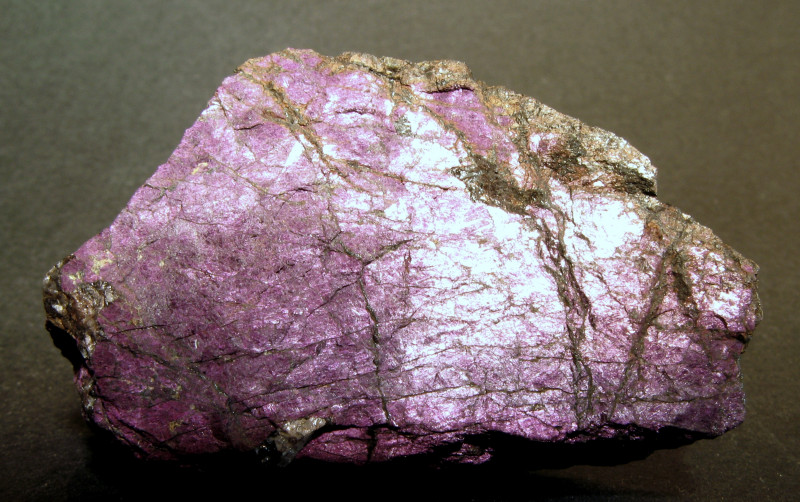 Image credit: Ra'ike | GNU Free Documentation License
Image credit: Ra'ike | GNU Free Documentation License
About Purpurite Stone
Purpurite is a rose red to rich purple semi-precious gemstone. It’s sometimes misspelled as “purpoliote” or “purpolite.” One alternate name for the stone is “manganipurpurite,” after its manganese content.
Like other purple crystals, purpurite is a natural birthstone for anyone born around December 21, the Winter Solstice. Likewise, it can also be worn as an alternative January birthstone.
Astrologically, purpurite is a zodiac stone for Virgo. The crystal’s rejuvenating and spiritual properties are perfect for helping any overworked Virgo from taking time for themselves to reflect.
Though researchers have created and used synthetic purpurite for scientific purposes, synthetic versions haven’t shown up in the jewelry world.
Purpurite Specifications & Characteristics
Purpurite is a manganese phosphate mineral with the formula MnPO4, though iron (Fe) impurities are so common, the formula is often written (Mn,Fe)PO4. The amount of iron inside a given purpurite stone often differs according to where it came from.
The mineral forms a series with the iron phosphate heterosite, with purpurite representing the manganese-dominant end. For this reason, purpurite may be called “manganian heterosite.” Purpurite is much rarer than heterosite, though.
Both heterosite and purpurite are in the triphylite group of anhydrous (waterless) phosphates. Other minerals in this group are sicklerite, lithiophilite, natrophilite, ferrisicklerite, karenwebberite, and of course, triphylite.
Though purpurite can form crystals, it more commonly occurs in small, stocky masses. It can occasionally form as a druzy.
Here are the rest of purpurite’s properties:
Mohs hardness: 4-4.5
Color: Violet, deep red/pink, magenta, purple; Often oxidizes (in part or completely) to brownish-black, brown, black
Crystal structure: Orthorhombic
Luster: Dull/earthy and satiny; Silky
Transparency: Translucent to opaque
Refractive index: 1.85-1.92
Density: 3.20-3.69
Cleavage: Good/Distinct on [100] & imperfect on [010]; These surfaces may be crinkled or curved
Fracture: Uneven/Irregular
Streak: Purple
Luminescence: None
Pleochroism: Strong in gray, greenish-gray, or rose-red and maroon or magenta
From appearance alone, you may wonder: is purpurite the same as sugilite? No, but we don’t blame you for the confusion!
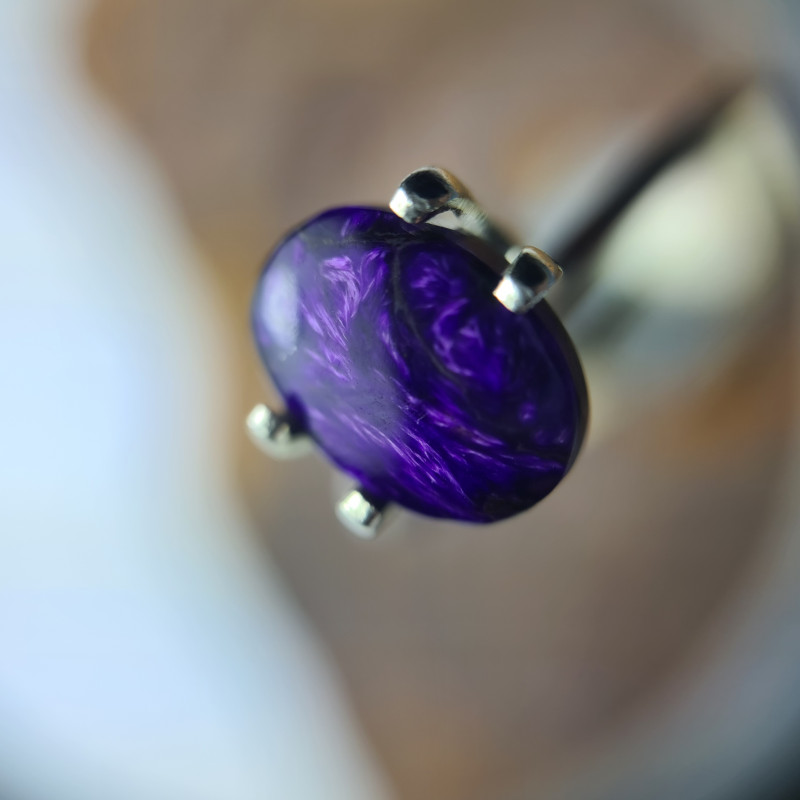 Pictured above: Sugilite
Pictured above: Sugilite
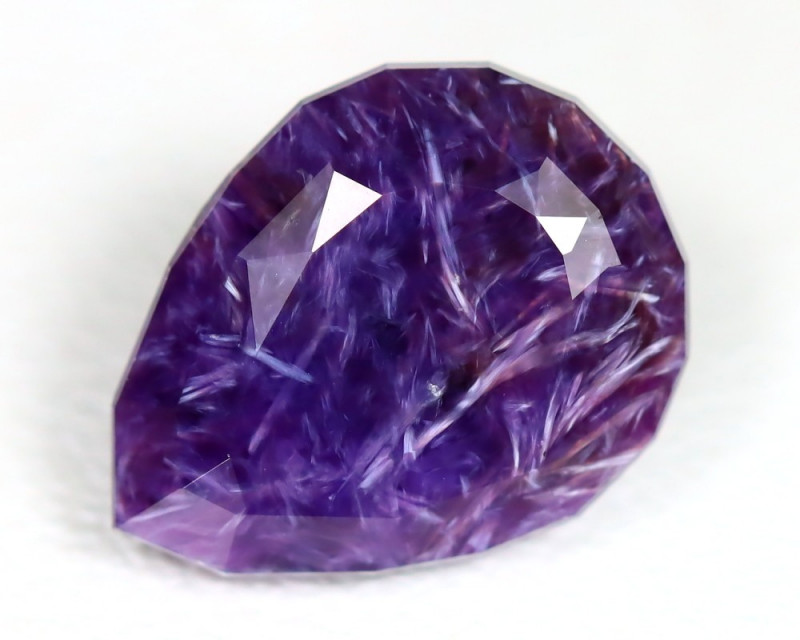 Pictured above: Charoite
Pictured above: Charoite
Purpurite vs. Similar Gemstones
The two gems that look the most like purpurite are sugilite and charoite. We’ll go over the individual differences below, but overall, purpurite is far rarer than either of these stones and less likely to be carved.
Here are the primary differences between purpurite vs. sugilite and charoite:
Hardness: Purpurite is lower on the Mohs mineral hardness scale than both charoite (at 5-6) and sugilite (at 6), making purpurite the softest of the three.
Refractive Index: Purpurite’s refractive index is significantly higher than that of charoite (1.54-1.56) or sugilite (1.60-1.61).
Streak: Purpurite has purple streak powder, while charoite and sugilite have white/colorless streaks.
Density / Specific Gravity: Purpurite is much denser (heavier) than charoite (2.54-2.78) or sugilite (2.74).
Now that you can tell purpurite apart from its violet companions, it’s time to look at purpurite’s origin!
Purpurite Meaning & History
Purpurite symbolizes liberation, intuition, and spirituality. Some call it the “Stone of Freedom.” Many also interpret the purpurite spiritual meaning to represent abundance, success, and growth.
The first discovery of purpurite occurred in Kings Mountain, North Carolina, USA. The original specimen currently resides with the Smithsonian Institute’s National Museum of Natural History in Washington, DC.
Two American geologists made the discovery: Louis Caryl Graton and Waldemar T. Schaller. Fun fact: Schaller is renowned not only for being the first to determine the chemical composition of turquoise, but also for providing the names and descriptions of 41 new minerals!
Schaller and Graton published their findings in the American Journal of Science in August of 1905 with the new mineral’s name as “purpurite” after the Latin purpura for “purple.”
While the two geologists were examining pegmatites in the North Carolina area in 1904, the mine’s superintendent, J.L. Daniels, pointed out the unusually striking mineral. Daniels also supplied the men samples for analysis, which they discovered to be the only known manganese phosphate (at the time).
Soon after, purpurite was also discovered in the famous Pala mines of California, the same mines where kunzite was discovered in 1902.
That covers origins. Now, what is purpurite good for?
Purpurite Healing Properties
Gemstones have vibrations and coloring that can influence their abilities as healing stones. In purpurite’s case, it joins other purple gemstones in representing creativity, magic, and spiritual intuition.
Because purpurite can become brown or black over time, it can also offer the grounding, balancing, and protective benefits of brown and black gemstones.
Additionally, purpurite is believed to be beneficial for financial stress, along with facilitating successful real estate transactions. Who knew?
What about the more specific purpurite benefits for physical, emotional, and chakra healing?
Physical Healing
Crystal healers use purpurite to help treat:
Bruises, cuts, and wounds
High blood pressure
Sunburns
Fatigue
High heart rate
Blood circulation issues
Emotional Healing
Purpurite is a great stone for encouraging creativity and problem-solving. It’s said to stimulate cognitive activity and focus, but also free you from toxic thought patterns.
By helping you let go of anxieties that hold you back, the “Stone of Freedom” is believed to help you speak your truth confidently. This makes it popularly recommended for use during public speaking and for personal growth goals.
Chakra Healing
Chakra healing involves resolving blockages of energy flow among your chakras (energy centers) to bring the entire system back into harmony. Being a highly spiritual crystal, purpurite is unsurprisingly a chakra stone for the two centers of spirituality: the third eye and crown chakras.
The third eye chakra governs intuition and awareness, while the crown chakra represents ascension and connection spiritually. When purpurite balances and harmonizes these chakras, you’ll likely feel confident in who you are spiritually and your place in the world.
Spiritual Healing
Spiritually, purpurite is all about ascension. These crystals are believed to harmonize your mental and emotional sides with your truest spiritual self. It can also help you harness stronger intuition and communication with higher beings, who can provide wisdom on your spiritual path.
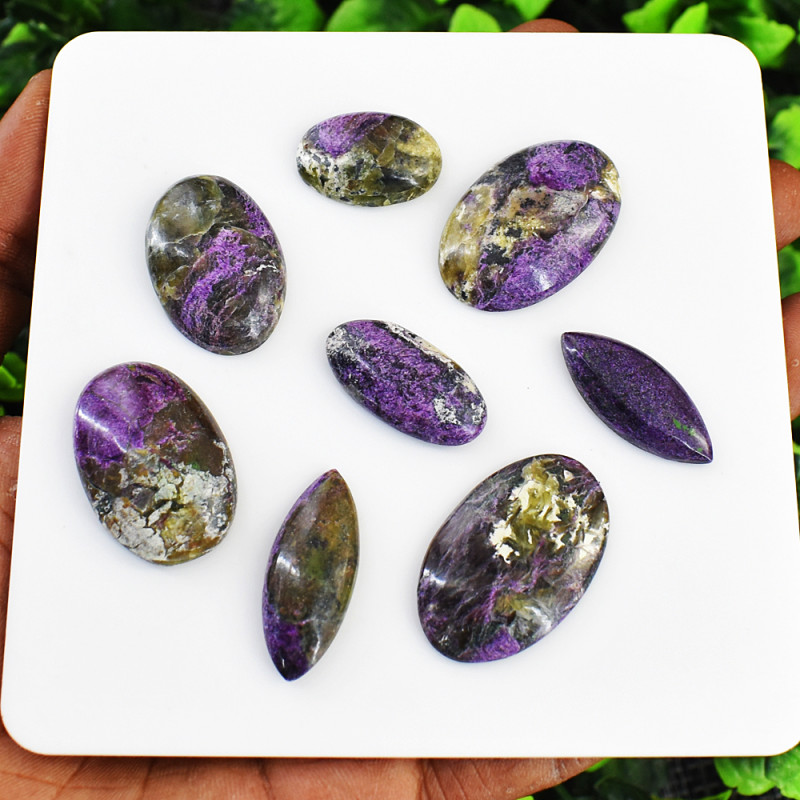
Purpurite Gemstone Properties
Though it’s not often used in jewelry, purpurite’s value is still determined by standard gemstone properties: color, cut, clarity, and treatments.
Color
Purpurite isn’t just a purple gem — it can show many shades! The possible purpurite colors include violet, deep red, burgundy, dark rose, brown, or black.
The red to purple hues in purpurite are caused by its manganese content. However, it’s often spotted or speckled with brown or black as well due to iron inclusions oxidizing. The amount of speckling depends on a particular purpurite’s iron content and the extent of weathering the stone has gone through.
Bright purple specimens with little to no brown or black coloring are most valuable.
Cut
Purpurite is hardly ever faceted, given its softness and cleavage. However, it makes gorgeous cabochons, beads, and carvings. Otherwise, it’s sold raw or polished in a freeform shape.
Clarity
Purpurite is almost always opaque, so it doesn’t have a colored gemstone clarity grade. Besides iron, other inclusions you might see in purpurite are sicklerite, lithiophilite, and apatite. These inclusions can create areas of yellow, white, or orange on purpurite stones.
Treatments
Because oxidation often turns purpurite brownish or blackish over time, jewelers often enhance purpurite’s color via acid treatment or acid etching.
Basic versions of this process involve quickly submerging the stone in a weak acid solution to make the color brighter. This may be followed with coating the stone in a stabilizer to prevent it from becoming oxidized again and losing its color.
Some sellers may dye the stone purple, but this often rubs off and is considered “fake purpurite” by many geologists.
When it comes to natural, untouched material, how does purpurite form?
 Image credit: Douglas Watts | Creative Commons Attribution 3.0 Unported license
Image credit: Douglas Watts | Creative Commons Attribution 3.0 Unported license
Purpurite Formation & Sources
Purpurite is a secondary mineral, meaning it forms when a different (primary) mineral is transformed by outside forces of some kind, be it weathering, chemicals, or otherwise.
In this case, purpurite starts as lithiophilite, a lithium manganese phosphate. The lithiophilite’s lithium content leaches out while manganese oxidizes.
This formation process mostly occurs in lithium-bearing pegmatites. Oftentimes, you’ll find purpurite crystals growing on top of triphylite, the primary mineral that can become heterosite.
Mining Locations
The largest, most cost-effective, gem-quality purpurite comes from Usakos, Namibia.
Purpurite can also be found in:
Australia
France
Portugal
USA (California, Maine, North Carolina, South Dakota)
Since it’s so rare, is purpurite valuable? Somewhat, yes, but it’s more affordable than you’d think!
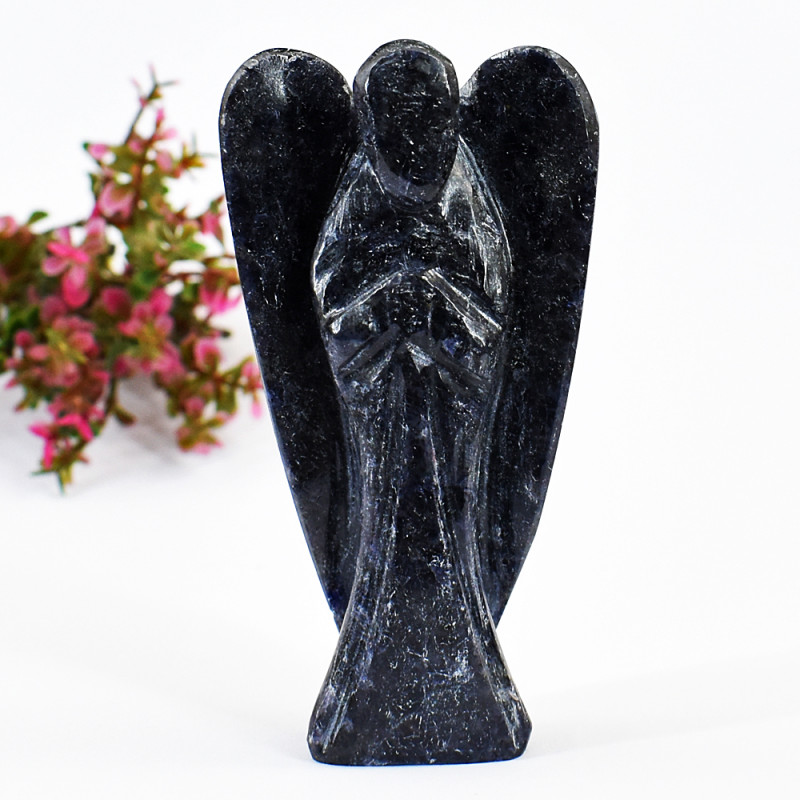
Purpurite Price & Value
Good news: many purpurite stones are very affordable! Most cabochons are around $0.33 per carat and tumbled stones are typically $4-$15 each.
However, some specimens are much pricier. Large purpurite spheres can reach $150, and well-polished tumbled stones may be $80-$200.
Rough purpurite generally fetches $10-$50, with a few specimens reaching $100.
Before we wrap up, you’ll need to know proper gemstone care.
Purpurite Care and Maintenance
If you manage to find purpurite jewelry, we recommend opting for protective settings and less vulnerable options (to prevent scratches) like pendants and earrings.
Can you wash purpurite? Yep! You can clean purpurite with the standard mild soap mixed with warm water, spread gently with a soft toothbrush. Follow that with a rinse and drying with a soft, dust-free cloth.
Just avoid hydrochloric acids and steam or ultrasonic cleaning systems. Store your purpurite stones away from other gems to prevent damage.
Claim Your Personal Power with Purpurite!
There are many associations with purple: creativity, calm, intuition, passion. Purpurite reflects all these qualities and more, allowing you to confidently explore your spiritual side or strengthen your confidence with the grace of nobles who’d often adorn themselves in this royal hue.
Whether you’re seeking spiritual awakening or just a pristine purple crystal to have around as visually soothing decor, purpurite may just be what you’re searching for!
Search the Gemstone Encyclopedia
Related Auctions
Related Articles
Originally the Birthstones or gemstones were associated with a zodiac sign or the month of a individuals birth. Find out what your stone is and view the stones we have for sale
8th Feb 2021
There are dozens of quartz and chalcedony gems with various colors and patterns. Learn all about quartz properties and every type of quartz, from amethyst and agate to plasma and phantom quartz!
15th Oct 2020
Hackmanite is a pink to violet sodalite gem known for its unique color-change and luminescence. Learn why hackmanite is special, from its rare qualities to the types of hackmanite jewelry available.
28th Mar 2018
Latest Articles
Catapleiite is a lesser-known mineral and rare gemstone often found as stunning tabular rosettes near other rare stones. Discover the history, prices, benefits, and properties of catapleiite!
28th Apr 2025
Yugawaralite is a rare colorless, white, or pinkish zeolite crystal named for its discovery in Yugawara, Japan. Here we uncover the multifaceted history, properties, prices, and uses of yugawaralite.
24th Mar 2025
Simpsonite is a lesser-known mineral known on the gem market for its durability, yellow-orange color, and rarity. Discover all the properties, uses, prices, and history of simpsonite.
3rd Mar 2025
Article Categories
How To's is where you will find helpful articles from gem Rock Auctions on how to cut gemstones, select gemstones and buy gemstones.
9 Articles




